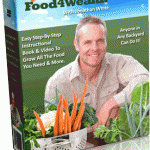Review: Food 4 Wealth Video Series
Welcome back, food-growing backyard gardeners. This is the second part of my review of the Food 4 Wealth system of ecological gardening.
When you receive your copy of Food 4 Wealth, you get a download link to several videos that help develop certain aspects of the system, like building your raised bed, layering your sheet mulch, composting, and managing your plot year-round. I watched them on the host site, and found the video quality quite good.
I did find a few things to criticize, and more to praise, so I’ll give you the bad news first.
I worked for twelve years in theater, film and television. Andrew is a professional film producer. I can’t look at videos without noticing how the medium is used. On the whole, I think Jonathan missed an opportunity to add a new dimension to the material.
Video is visual. You should SHOW what you are discussing. A lot of the video was just a medium shot of Jonathan teaching. I wanted to see all the materials he used to put the raised beds together. I wanted to see his kitchen scraps going into the compost. There are some “action shots” used to good effect, such as planting seedlings or collecting and scattering seed to get more diversity in the plot. I wanted more showing and doing, rather than talking.
Next, I have to mention the editing. Several times I noticed Jonathan pause and then repeat a phrase or paragraph he had just said, with slightly different emphasis or wording. At first I thought it was his teaching style, or that he was forgetful. Then I recognized he was doing “pickups.” When you flub your lines on video or want to give a different delivery, you pause for the editor to cut the correct “takes” together. Well, apparently the editor didn’t show up.
The last criticism, and the only one based on content, is about materials for building the raised beds. Jonathan mentioned that in his own test plot, he uses a combination of materials including treated pine and old railway ties. Now, from everything I have been reading about organic gardening, this is a big no-no. He does acknowledge that treated pine is a bit controversial for use around edible plants, and may not be allowed if you want to sell produce certified as “organic”. However, he doesn’t address the use of railroad ties, which from my reading, are so heavily treated they turn into absolute cesspools of toxic chemicals. However, I can see that Jonathan has only the one head, and no apparent extra eyeballs, so perhaps the dangers of leaching from railroad ties are exaggerated? But it did take me aback.
On the plus side, the videos add a level of detail that goes beyond the book. I mentioned in the book review a lack of information about adapting the plan to personal situations. The videos fill in those gaps.They teach you how flexible the system is, and how to incorporate your changes. It is even easier than the book made it sound, and that’s pretty easy!
I learned a lot that had not sunk in before, especially about seasonal management and how to prepare and plant winter crops so the plot can produce year-round. Some of the information in the videos is new, and some is presented in a new way so that you understand and remember it better.
Jonathan’s delivery is very engaging and encouraging. He’s obviously passionate about what he does and loves to teach others. His manner not only makes you feel you can grow your own garden, it makes you want to jump up and start planting that minute!
Overall, the technical issues are mildly annoying, but the videos add a lot of value to the package because of their in-depth information and the impact of Jonathan’s teaching style. They make my recommendation of the product even stronger.
Learn more about Food 4 Wealth and watch Jonathan in action HERE!